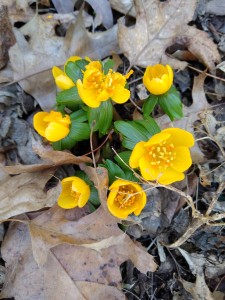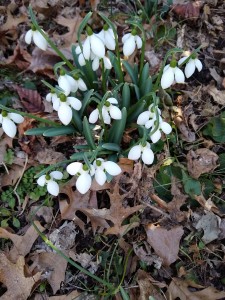 This year, Presidents’ Day marked the first foray into the winter-struck garden. The temperature was finally above 45 degrees, the endless rain had stopped, and it was a Federal holiday. That trifecta of events was the winning combination that sent me out of doors first thing in the morning. I reconnoitered, pulled out the garden tools and generally felt the onset of spring. The sap is rising—in trees and gardeners—almost as fast as the onion grass.
This year, Presidents’ Day marked the first foray into the winter-struck garden. The temperature was finally above 45 degrees, the endless rain had stopped, and it was a Federal holiday. That trifecta of events was the winning combination that sent me out of doors first thing in the morning. I reconnoitered, pulled out the garden tools and generally felt the onset of spring. The sap is rising—in trees and gardeners—almost as fast as the onion grass.
The start of real spring is still a month away, but in my garden the stirrings have started, with snowdrops, winter aconite, hellebores and early crocus making themselves known. The daffodils are well up above the ground and in a few places you can see their flower buds. It might still snow, because the end of February can be unpredictable, but the plants will survive.
At this time of the year my yard always looks awful, a study in browns and grays livened only by the stalwart leaves of evergreen plants like holly and winter creeper or euonymus.
And then there is the debris. I tell people that the remnants of last season’s asters and mums were preserved so that the birds could feast on the seeds. I love the birds, but even if I had no commitment to them at all, the debris would probably still dominate the spring garden. Fall generally gets too busy too quickly to allow time for total tidiness. My feathered garden visitors benefit from my sins of omission.
Even days off are busier than I would like, so long blocks of garden clean-up time are not often part of my life. That fact makes the untidy garden a bit overwhelming. I deal with that by taking apart the problem and deal with the clean-up incrementally.
On Presidents’ Day, I started with a four-by-six foot segment of the back garden that contains a vigorous hydrangea, the remains of some asters and fall-blooming anemones, an overhanging butterfly bush and a ground-covering crop of dead leaves. A few brown flowerheads still clung to the hydrangea and the butterfly bush was drooping sadly over the whole mess. I started with the easiest chore first and cut the desiccated perennial stalks down to the ground. The butterfly bush branches were an impediment to further progress, so I armed myself with the long-handled loppers and cut them all back by two thirds. 
Nature loves thirds and when pruning just about anything, aim to lop off either one or two thirds of the length of each branch.
Old-fashioned hydrangeas, like the much-loved ‘Nikko Blue’, bloom on “old wood” or last year’s growth. As I clipped the dead branches and removed the long-spent flowerheads from mine, I was careful to watch for the buds that are waiting to spring to life and produce flowers later this year. Those living buds are fairly easy to spot on each branch, but if you prune without thinking, you will probably lose a good portion of those nascent flowerheads. The centers of mature hydrangeas are often full of dead branches from previous seasons and they are usually easy to pull out. Getting them taken care of now, before the plant leafs out, makes for a better looking specimen the rest of the year. The dead branches are often white, as opposed to brown, and snap easily.
Once the worst of the hydrangea clean-up is finished, I can finally rake up the accumulation of dead leaves that have covered and insulated the ground since the fall. I rake carefully so as not to disturb spring-blooming plants emerging from the ground. I am awaiting a new composter, so I can’t dispose of the leaves that way. Since my clean-up day was dry, I spread them over the lawn and ran my electric mower over them. This immediately reduces the pile to tiny bits that enrich the lawn and garden soil. It also spares me from having to bag them up and take them to the curb.
This technique is useful in suburban gardens, because even if you have a composter, it may not be able to accommodate the accumulation of leaves that comes all at once during spring or fall clean-up.
With the leaves taken care of, all I have to do is bundle up the branches clipped from the hydrangea and the butterfly bush and put them out for trash pick-up. Even though I have only dealt with a small portion of my garden, I look at the results with great satisfaction. Each small cleaned-up area represents a big victory in the war on winter garden debris.
